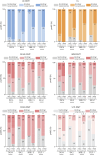COVID-19 Vaccine Boosters in People With Multiple Sclerosis: Improved SARS-CoV-2 Cross-Variant Antibody Response and Prediction of Protection
- PMID: 40694731
- PMCID: PMC12285670
- DOI: 10.1212/NXI.0000000000200443
COVID-19 Vaccine Boosters in People With Multiple Sclerosis: Improved SARS-CoV-2 Cross-Variant Antibody Response and Prediction of Protection
Abstract
Background and objectives: Although disease-modifying therapies (DMTs) may suppress coronavirus disease 2019 (COVID-19) vaccine responses in people with multiple sclerosis (pwMS), limited data are available on the cumulative effect of additional boosters. Maturation of Spike immunoglobulin G (IgG) to target a greater diversity of SARS-CoV-2 variants, especially past the BA.1 variant, has not been reported. In addition, the prediction of variant-specific protection, given that Spike antibody testing is not performed routinely, remains a challenge. We, therefore, evaluated whether additional vaccine doses improved the breadth of cross-variant recognition to target emerging SARS-CoV-2 variants. Machine learning-based models were designed to predict variant-specific protection status.
Methods: In a prospective observational cohort (n = 442), Spike IgG titers and live virus neutralization against D614, BA.1, BA.2, BA.5, XBB.1.1, XBB.1.5, and EG.5.1 variants were determined in 1,011 serum samples (0-12 months after 2-4 doses). Predictive protection models were developed by K-fold cross-validation on training and test data sets (random split 70:30).
Results: After primary vaccination, pwMS on immunosuppressive disease-modifying therapy (IMM-DMT) had 10-fold and 7.2-fold lower D614 Spike IgG titers than pwMS on low-efficacy (LE)-DMT and cladribine (p < 0.01). After 4 doses, pwMS on IMM-DMT had significantly lower Spike IgG titers, compared with pwMS on low-efficacy disease-modifying therapy, for D614 (p < 0.05), as well as BA.1, BA.2, BA.5, XBB.1, XBB.1.5, and EG.5.1(p < 0.01). The breadth of Spike IgG to recognize variants other than the cognate antigen increased after 4 doses of all DMTs. Although pwMS on IMM-DMT displayed reduced cross-variant recognition, a fourth dose resulted in a 2-4-fold increase in protection against newer variants and a reduction in two-thirds of pwMS without protective Spike IgG (p < 0.0001). Tixagevimab and cilgavimab did not induce additional cross-variant protection. Variant-specific predictive models of vaccine protection were influenced by treatment, time since primary vaccination, and age, with high sensitivity (99.4%, 95% CI 96.8-99.99) and specificity (72.0%, 95% CI 50.6-87.9) for XBB.1.5/EG.5.1 variants.
Discussion: Despite not eliciting adequate antibody response in pwMS on IMM-DMT, COVID-19 boosters improve the breadth of the humoral response against SARS-CoV-2 emerging variants. Vaccine protection can be predicted by statistical modeling.
Figures






References
Publication types
MeSH terms
Substances
Supplementary concepts
LinkOut - more resources
Full Text Sources
Medical
Miscellaneous
